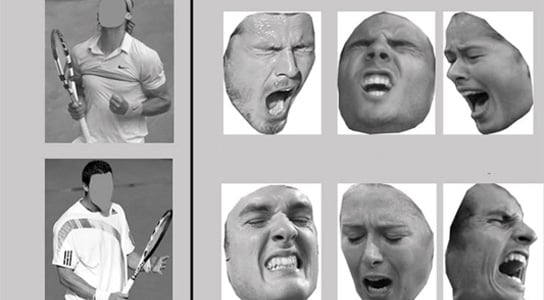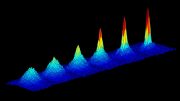
Without body cues, it’s hard to tell if these tennis champs are winners or losers. Credit: H. Aviezer et al., Science
Intense emotional experiences are more easily read in body language than in watching facial expressions. Facial clues in most studies rely on a set of stylized, recognizable expressions, which don’t reflect the expressions that people make in the real world.
The scientists published their findings in the journal Science. Hillel Aviezer, a neuropsychologist at the Hebrew University of Jerusalem, and lead author, suggests that when emotions get extreme, like when people are undergoing fleeting peaks of intense pain, joy, grief, or anger, these could look surprisingly similar, at least on their faces.
However, most people aren’t confused whether someone they see is experiencing grief or joy. To figure out how people distinguish the difference, the scientists showed photos of professional tennis players to 45 Princeton University students, randomly divided into three groups of 15. Each tennis player had won or lost an important match. The participants rated the players’ facial expressions from negative to positive, on a scale of 1 to 9, with 5 marking a neutral point. One group looked at full-body photos, one looked only at the players’ bodies while the last group looked at only their heads. Only the last group had trouble making the right identification, indicating that facial expressions alone didn’t give the participants enough cues.
The images were then doctored, switching the winning player’s head with those of the losers. Participants still labeled the winners or losers according to the players’ posture, not their facial expressions. In subsequent interviews, researchers learned that whether hands were open or clenched were more important in determining whether a player was deemed a winner than facial cues.
Yet, in another experiment that asked 20 participants to state whether they would use body language, facial expressions, or both to evaluate emotion, 80% believed that they could judge the full-body photos by facial expression alone. That underscores the bias toward facial expressions and how little we credit body language.
In a further experiment using photos of people in high-intensity situations, from funerals to orgasms, without body language to provide context, viewers struggled to correctly read facial expressions.
The results of this study could possibly help people that have difficulty recognizing facial expressions. “Maybe we should zoom out from isolated faces when we teach people how to read emotion, looking at what’s happening in the surroundings, then body and then the face,” states Aviezer.
Reference: “Body Cues, Not Facial Expressions, Discriminate Between Intense Positive and Negative Emotions” by Hillel Aviezer, Yaacov Trope and Alexander Todorov, 30 November 2012, Science.
DOI: 10.1126/science.1224313









Be the first to comment on "Body Language Is a Better Indicator of Intense Emotions Than Facial Expressions"